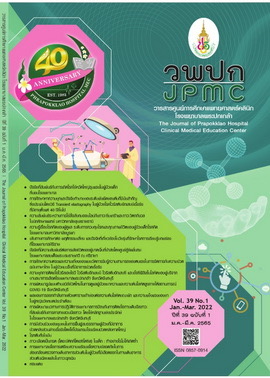Community Participation in Rehabilitation of Patients with Chronic Low Back Pain Using Hat Yai Back School Program
Main Article Content
Abstract
BACKGROUND: Chronic low back pain is a common musculoskeletal symptom affecting several factors, including physical and mental health as well as economy.
OBJECTIVES: To examine the effectiveness of the Hat Yai Back Pain school program, along with community participation, regarding pain reduction, lumbar spine range of motion, and disability among chronic low back pain patients.
METHODS: This quasi-experimental research was conducted from May 2019 to January 2020. Thirty people, who were diagnosed with chronic low back pain and consulted with the multidisciplinary team for pain relief, were recruited. The participants were followed up at 2-week, 1-month, 3-month and 6-month intervals during the intervention. The instruments consisted of a general data record form and a record form m the indicators in this study. The data in this study are presented in terms of percentage, mean, and standard deviation, and the hypothesis was tested using a repeatable one-way analysis of variance.
RESULTS: The findings showed that, after the intervention and during the follow-up period, the average scores for resting pain, lumbar spine range of motion, and disability were not statistically significantly improved over the baseline (p>0.05). However, after intervention at 1-month, 3-month, and 6-month intervals, they showed statistically significant improvement with p<0.05. The findings showed no statistically significant difference in mean NRS, Schober’s test, and RMDQ when comparing the results of participants before and after participating in the Hat Yai Back Pain School program for 2 weeks (p>0.05). Comparing the participants results before and after the program at 1-month, 3-month, and 6-month intervals, it was found that NRS, Schober’s test, and RMDQ were statistically significantly different (p<0.05).
CONCLUSIONS: The Hat Yai Back School program, when combined with community participation, can be applied to improve health service quality for chronic low back pain patients, particularly regarding pain reduction (NRS), increased lumbar spine range of motion (Schober’s test) and reduced disability (RMDQ). This also enhances patients’ knowledge and selfcare management behaviors, thus reducing NRS, improving Schober’s test, and reducing RMDQ. The program also better informs patients with chronic lower back pain of their condition and improves their behavior in taking care of themselves.
Article Details

This work is licensed under a Creative Commons Attribution-NonCommercial-NoDerivatives 4.0 International License.
References
Maher C, Underwood M, Buchbinder R. Non-specific low back pain. Lancet 2017; 389(10070):736–47.
Traeger A, Buchbinder R, Harris I, Maher C. Diagnosis and management of low-back pain in primary care. CMAJ [Internet].2017 [cited 2021 June 22];189(45):E1386–95. Available from: https://www.cmaj.ca/content/cmaj/189/45/E1386.full.pdf
Tassanawong P, Chanthorn W, Rakprasit J. Prevalence and factors associated with musculoskeletal disorders among tea farmers, Thoet Thai subdistrict, Mae Fa Luang district, Chiang Rai province. Srinagarind Med J 2018;33:457–64.
Jiraratphonchai K. Spine disease empirical evidence, V1. Khon Kaen: Khon Kaen University Printing; 2011.
Jackson CP, Klugerman M. How to start a back school. J Orthop Sports Phys Ther 1988;10:1-7.
Tiwawatpakorn J, Wongkiratimethawi T, Areeudomwong P. Long Term Effects of Back School Program in Patients with Chronic Low Back Pain. Mahidol R2R E-J. 2021;8(3):59–73.
Tiwawapakorn J, Sutheeravat P. Collaboration of patients undergoing chronic low back pain rehabilitation by community participation, Songkhla province, Thailand. Thai Journal of Public Health 2021;51(1):75–87.
Wongwilairat K. Potential development for self-care low back pain people: Moo 2, Nonsaad, Sub-district, Nonsaad District, Udonthani Province. [dissertation]. Khon Kaen: Khon Kaen University; 2011.
Office of the National Economic and Social Development Board. The twelfth national economic and social development plan (2017-2021). Bangkok: Office of the Prime Minister; 2017.
Mannion AF, Balagué F, Pellisé F, Cedraschi C. Pain measurement in patients with low back pain. Nat Clin Pract Rheumatol 2007;3:610-8.
Prommanon B, Puntumethakul R, Puengsuwan P, Chatchawan U, Rittitod T. Comparison of Intra-tester Reliability for measuring active lumbar range of motion by three methods in healthy subjects: a preliminary study. KKU Res J (GS) 2013;13(3):58–67.
Jirarattanaphochai K, Jung S, Sumananont C, Saengnipanthkul S. Reliability of the Roland - Morris Disability Questionnaire (Thai version) for the evaluation of low back pain patients. J Med Assoc Thai 2005 Apr 1;88:407–11.
Student. The probable error of a mean. Biometrika1908;6:1–25.
Durmus D, Unal M, Kuru O. How effective is a modified exercise program on its own or with back school in chronic low back pain? A randomized-controlled clinical trial. J Back Musculoskelet Rehabil 2014;27:553-61.
Kaplansky BD, Wei FY, Reecer MV. Prevention strategies for occupational low back pain. Clin Occup Environ Med 2006;5:529-44.
Bhadauria EA, Gurudut P. Comparative effectiveness of lumbar stabilization, dynamic strengthening, and Pilates on chronic low back pain: randomized clinical trial. J Exerc Rehabil 2017;13:477-85.

